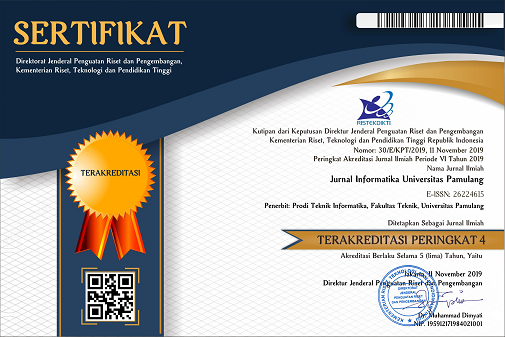Rancang Bangun Sistem Informasi Pengorderan Air Minum RO dengan Metode Waterfall Integrasi UML di PT Gajah Tunggal Tbk
DOI:
https://doi.org/10.32493/informatika.v6i3.11780Keywords:
Drinking water, Employee, Repeat Order (RO), Waterfall, UMLAbstract
The increasingly high level of competition in the tire industry encourages companies to manage their human resources well. Human resources are the company's main asset which is an important element in achieving company goals and maintaining company sustainability. Every employee is an important factor that drives a high-performing compan, therefore the company strives to provide facilities for all its employees. The facilities provided by PT. Gajah Tunggal Tbk is healthy drinking water for all its employees. The problem is the process of ordering healthy drinking water is still manual, each division goes to the RO section to order drinking water and reports often do not match the needs in the field. This makes the division lose a lot of time and effort. Because of this, with the development of information technology, the solution is to build a web-based RO drinking water ordering application system. The website design method uses the Waterfall method which is integrated with the UML software development method. With Black box testing, it is proven that the design of this RO drinking water ordering application can help the activities of employees in the company in meeting the needs of drinking water and accurate reports so that it becomes effective and efficient. in the working time of employees and this can improve the performance of employees of PT. Gajah Tunggal Tbk
References
X. Zhang, B. Zheng and L. Pan. (2020). Using Virtual Reality Technology to Visualize Management of College Assets in the Internet of Things Environment. IEEE Access, vol.8, pp.157089-157 102.Doi:10.1109/ACCESS.2020.3019836.
Y. Zhang and X. Gao. (202). Implementation of Online Guiding Framework based on Multimedia and PHP under the Influence of New Coronavirus. International Conference on Electronics and Sustainable Communication Systems (ICESC), pp.619-623,Doi:10.1109/ICESC48915.2020.915 5949.
R. Parlika and P. W. Atmaja. (2020). Realtime monitoring of Bitcoin prices on several Cryptocurrency markets using Web API, Telegram Bot, MySQL Database, and PHP-Cronjob.6th InformationTechnologyInternational Seminar (ITIS), pp. 253-257, Doi: 10.1109/ ITIS50118.2020.9321109
Y. Yang, W. Ke, J. Yang and X. Li, (2019). Integrating UML with Service Refinement for Requirements Modeling and Analysis. IEEE Access, vol. 7, pp. 11599-11612.Doi:10.1109/ACCESS.2019. 2892 082.
A. Hafeez Khan, S. Hyder Abbas Musavi, A. Rehman and A. Shaikh. (2017). Ontology-Based Finite Satisfiability of UML Class Model.IEEE Access, vol.6,pp.3040-3050.Doi:10.1109/ACCESS.2017 2786781.
Samuel Szoniecky. (2018). Graphical Specifications for ModelingExistences. in Ecosystems Knowledge: Modeling and Analysis Method for Information and Communication, Wiley, pp.89-115.Doi: 10. 1002/9781119388777.ch4.
L.Ordinez, G. Eggly, M. Micheletto and R. Santos. (2020). Using UML for Learning How to Design and Model Cyber-Physical Systems. IEEE Revista Iberoamericana de Tecnologias del Aprendizaje, vol. 15, no. 1, pp. 50-60. Doi: 10. 1109/RITA.2020.2978416.
S.I. Adam and S. Andolo. (2019). A New PHP Web Application Development Framework Based on MVC Architectural Pattern and Ajax Technology.1st International Conference on Cybernetics and Intelligent System (ICORIS), pp. 45-50, Doi:10.1109/ICORIS. 2019 .8874912.
M. M. Eyada, W. Saber, M. M. El Genidy and F. Amer. (2020), Performance Evaluation of IoT Data Management Using MongoDB Versus MySQL Databases in Different Cloud Environments. IEEE Access, vol. 8, pp. 110656-110668. Doi: 10.1109/ACCESS.2020.3002164.
Pressman R, S. (2015). Rekayasa Perangkat Lunak. Penerbit Andi Yogyakarta, Hal 42.
T. H. Chang, J. Larson, L. T. Watson and T. C. H. Lux, (2020), Managing Computationally Expensive Blackbox Multiobjective Optimization Problems with Libensemble, Spring Simulation Conference (SpringSim), pp.1-12. Doi:10.22360/SpringSim. 2020.HPC.001.
J. Pan, (2020), Blackbox Trojanising of Deep Learning Models: Using Non-Intrusive Network Structure and Binary Alterations, IEEE Region 10 Conference(TENCON),pp.891-896.Doi:10.1109 /TENCON50793.2020.9293933.
R Guidotti, A Monneale, F Giannotti, D Pedreschi, S Ruggieri F Turini, (2019), Factual and Counterfactual Explanations for Black Box Decision Making, IEEE Intelligent Systems ,Vol 34,No6,pp,14-23. Doi:10.1109/MIS.2019. 29572 23
Downloads
Published
Issue
Section
License
Authors who publish with this journal agree to the following terms:
- Authors retain copyright and grant the journal right of first publication with the work simultaneously licensed under a Creative Commons Attribution-NonCommercial 4.0 International (CC BY-NC 4.0) that allows others to share the work with an acknowledgement of the work's authorship and initial publication in this journal.
- Authors are able to enter into separate, additional contractual arrangements for the non-exclusive distribution of the journal's published version of the work (e.g., post it to an institutional repository or publish it in a book), with an acknowledgement of its initial publication in this journal.
- Authors are permitted and encouraged to post their work online (e.g., in institutional repositories or on their website) prior to and during the submission process, as it can lead to productive exchanges, as well as earlier and greater citation of published work (See The Effect of Open Access).
Jurnal Informatika Universitas Pamulang have CC-BY-NC or an equivalent license as the optimal license for the publication, distribution, use, and reuse of scholarly work.
In developing strategy and setting priorities, Jurnal Informatika Universitas Pamulang recognize that free access is better than priced access, libre access is better than free access, and libre under CC-BY-NC or the equivalent is better than libre under more restrictive open licenses. We should achieve what we can when we can. We should not delay achieving free in order to achieve libre, and we should not stop with free when we can achieve libre.
Jurnal Informatika Universitas Pamulang is licensed under a Creative Commons Attribution-NonCommercial 4.0 International (CC BY-NC 4.0)
YOU ARE FREE TO:
- Share : copy and redistribute the material in any medium or format
- Adapt : remix, transform, and build upon the material for any purpose, even commercially.
- The licensor cannot revoke these freedoms as long as you follow the license terms





